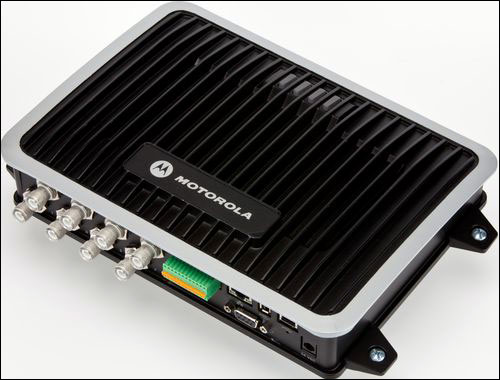Motorola Solutions has released a new industrial fixed RFID reader that, according to the company, is more sensitive than its predecessors—the XR series—and that is designed to provide improved read range and accuracy in harsh environments. The FX9500 reader, the firm explains, was developed to meet the needs of the most challenging applications: industrial sites with densely packed tagged goods, or containing a large presence of liquids and metals. The device, which will replace the XR series, will begin shipping to customers at the end of this month, Motorola reports. The XR series will be phased out over the course of approximately a year, says Chris Schaefer, Motorola Solutions’ director of global RFID market development. The FX9500 model, he indicates, “was designed for high-volume, high-density, high-throughput applications.”
The new interrogator features a smaller footprint than the XR series, and is designed for installation in portals, such as the dock doors of warehouses and manufacturing facilities, where forklifts may carry densely packed goods with 1,000 or more tags surrounded by metal or liquid containers.
“As RFID use has expanded in the market, people started with the low-hanging fruit,” Schaefer says—namely, simple RFID reading applications in which tagged cartons could be easily interrogated at a reader portal. However, he notes, as usage has expanded, the limitations of existing readers have become more apparent, especially for tagged items or cartons in which tags are located in the center of a pallet loaded with goods that passes a portal reader. “Now,” he states, “we are moving to the more challenging [applications].”
The FX9500 reader offers improved read accuracy and longer read ranges, Schaefer says, though he declines to specify how much greater the accuracy or read range would be. The device comes with either monostatic or bistatic configurations, with either four or eight antenna ports, enabling it to operate several portals simultaneously. Although Schaefer is unable to provide statistics regarding the higher sensitivity or read range, he reports that the FX9500 model “will set a new benchmark for performance in this space.” The higher performance, he adds, is the result of Motorola engineers’ “slightly more complicated design, with a higher number of specialized RF components.”
Motorola Solutions subjected the new reader to approximately six months of testing with potential end users, Schaefer says, noting that “those folks were extremely happy with the results.” Testing, he explains, consisted of placing more than 1,000 tags within the reader’s field of view, in “the kind of high-volume, high-performance scenarios for which it was designed, including real-world environmental testing designed to validate its use in challenging industrial environments.”
The new reader has a list price of $1,695 for the four-port model, and $1,995 for the eight-port version. The device measures approximately 7 and 3/16 inches by 9 and 5/8 inches—about one-third smaller than its XR series counterparts. While the FX9500 does not natively support power-over-Ethernet (PoE), its power draw is within the limits of the PoE+ standard (IEEE 802.3at-2009), permitting the use of third-party PoE+ splitters and enabling the convenience of single-line installation.


